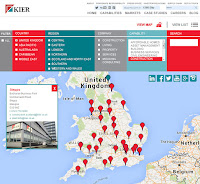 |
| Festive fun at CMA15 |
The Ghost of Christmas Past
Our big external campaign this year was #KierHeroes which comprised 22 individual minute long videos interviewing key personnel throughout the business. As I have mentioned before, this is something which Kier has not previously tried and we were delighted to be shortlisted at our first ever Construction Marketing awards event which took place on 9th December at the Radisson Blu in Portman Square. |
| The Kier Marketing Team (L to R), Claire Savage, Me, Paul Humphrey, Kristy Myrie |
The Ghost of Christmas Present
Our use of Trello continues apace and I have now trained the entire team which means we are up and running with it as a project management system. Even I am surprised with how well it is received and it's taken our productivity to a new level. Some of the advanced tools such as filtering (allowing us to see which of our own tasks are most urgent and real-time project progress) are really coming into their own and some team members have even started using it to plan their Christmas shopping! |
| Mock up of our new interactive map |
We have also begun the complete rebuild of our new offices map. This is in unison with our offline brand audit and will contain dynamically updated and filterable content. The benefits of which cannot be underestimated seeing as our 105 office locations are the most searched for thing internally and externally. Watch this space for more details in the future...
The Ghost of Christmas Yet to Come
As a central team one of our main responsibilities is to provide the business with tools to assist them to win work and to communicate the brand. Therefore, our first task for 2016 will be to build a central online 'hub' where all of our services can easily be accessed in one place. We have just begun the mapping stage and this will comprise of services which we manage such as graphic design, promotional goods and film and photography.The two main interactive elements will be a briefing form whereby colleagues can request one of the above services for it to be piped through to the relevant supplier. The benefits of this being that we can automate the tracking of requests and ensure that when briefs are submitted they contain all of the required detail.
 I have also been looking into digital solutions to assist with communicating our brand and have found an excellent service called Frontify. With this we can upload all of brand guidelines and allow them to be searchable, shareable and downloadable in all required formats.
I have also been looking into digital solutions to assist with communicating our brand and have found an excellent service called Frontify. With this we can upload all of brand guidelines and allow them to be searchable, shareable and downloadable in all required formats.As 2015 draws to a close I can truly say that it has been, professionally, one of the most exciting years yet. I still feel like I am always learning and I've really welcomed the many social events of this festive season to help reassure me that we have a fun and creative bunch of people working in our team. However, a combination of late nights out, a young family, and a busy job, definitely means I'm more than ready for the Christmas break to recharge my batteries for what is yet to come...























































